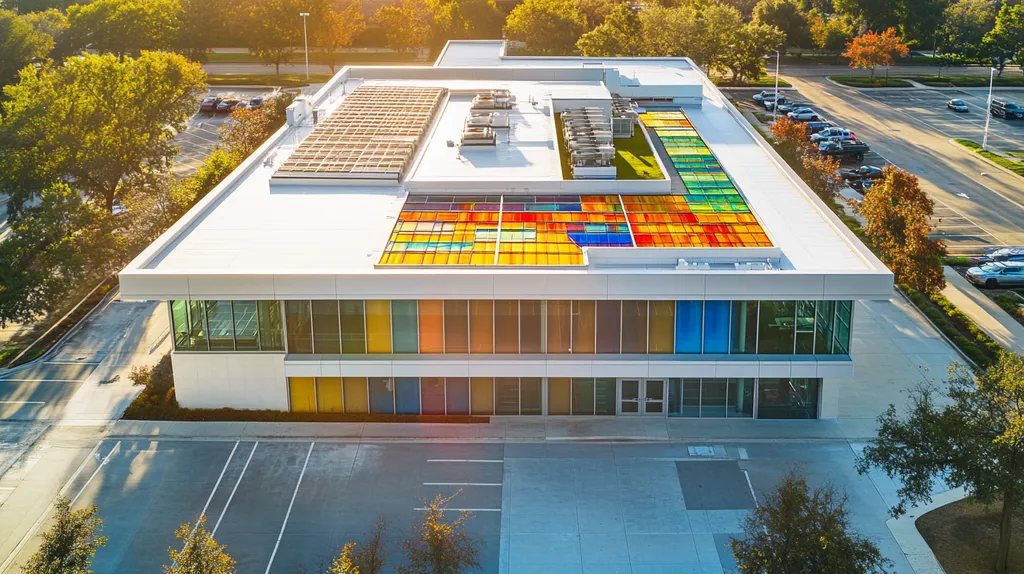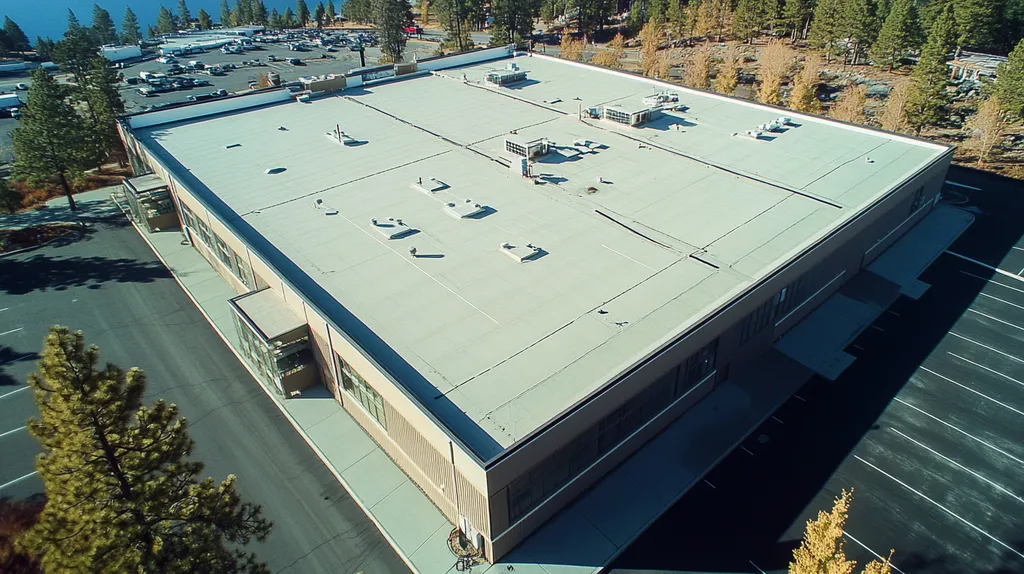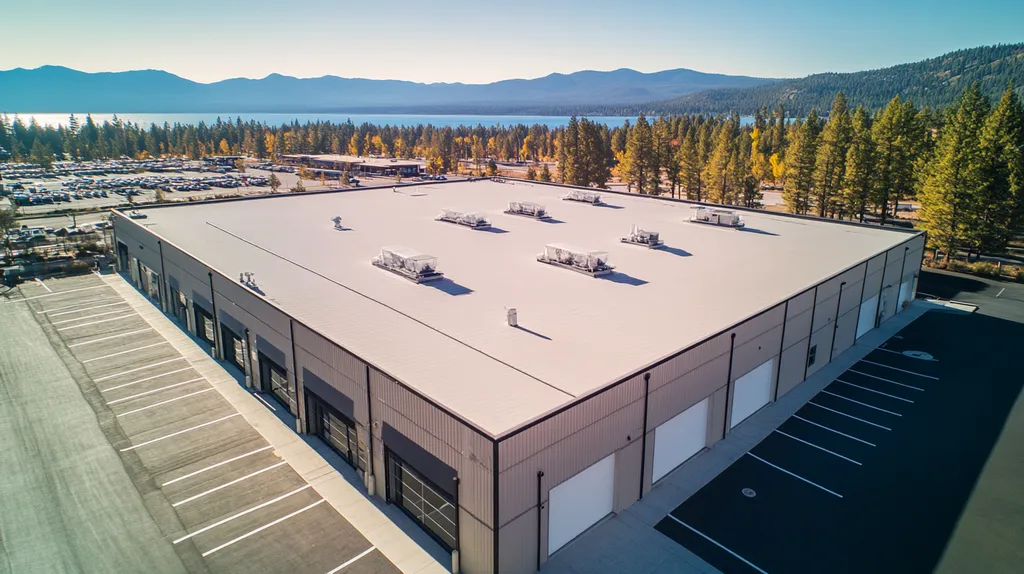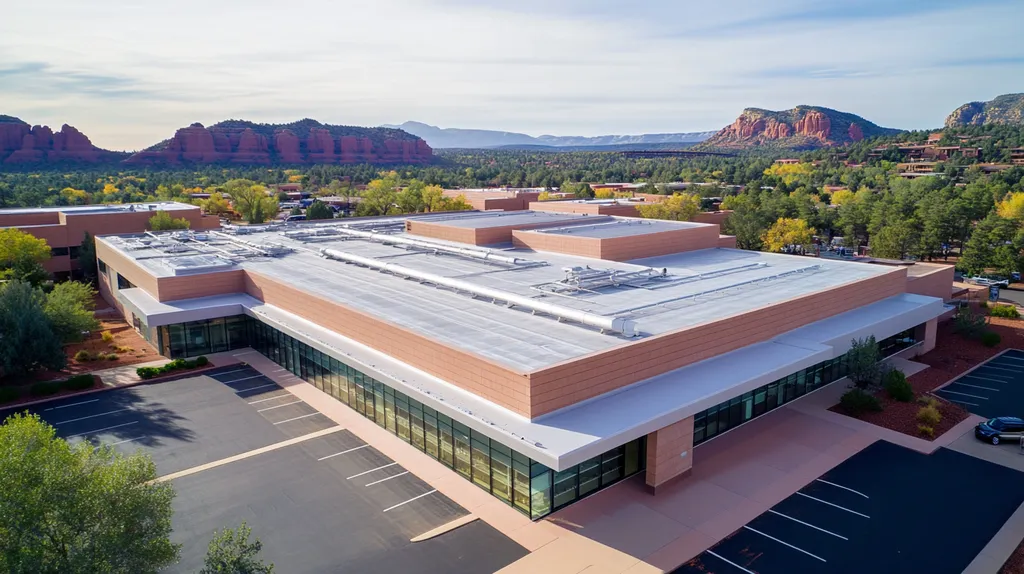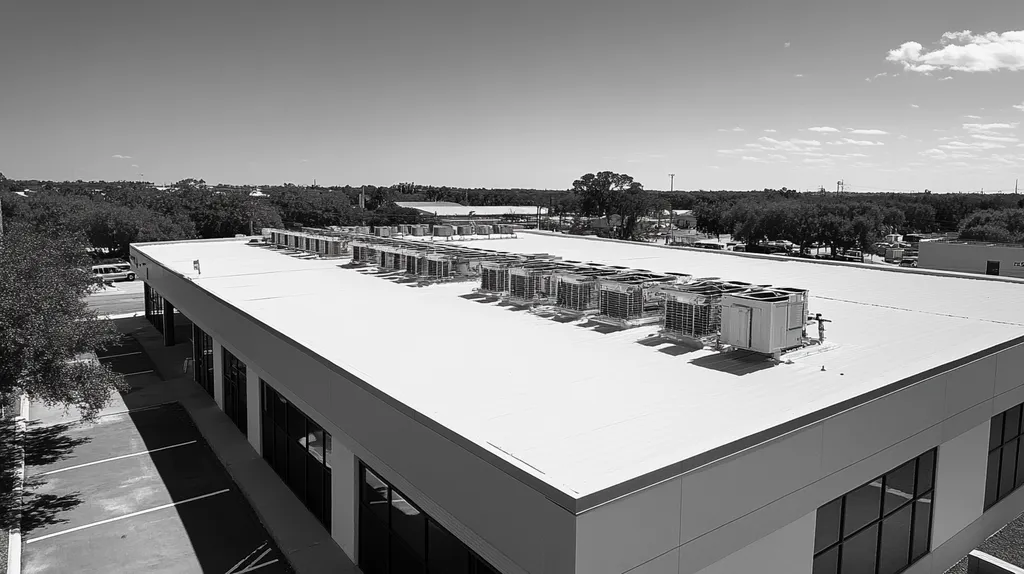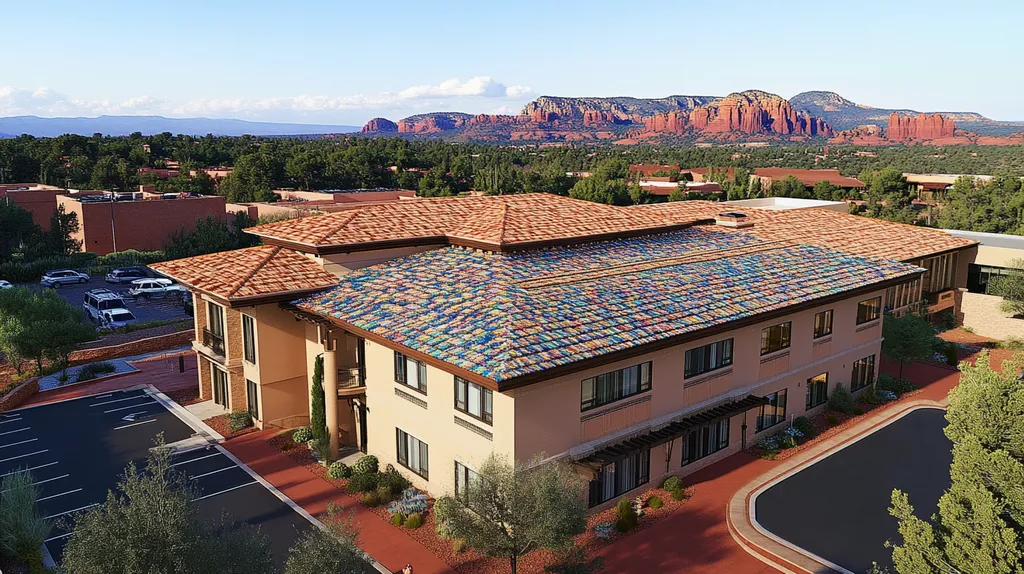In today’s industrial facilities, inaccurate roofing cost assessments lead to an average 30% budget overrun, threatening both operational efficiency and long-term profitability. Recent industry studies indicate that over $2.1 billion is wasted annually due to poor estimation practices and outdated calculation methods.
From rule-of-thumb estimates to overlooked site-specific factors, numerous misconceptions continue to plague industrial roofing projects. These errors cascade into significant financial consequences, affecting everything from project timelines to warranty compliance.
This comprehensive analysis examines the true costs of industrial roofing, offering evidence-based solutions for accurate assessment and long-term success.
SECTION 1: COMMON MISCONCEPTIONS
Many commercial and industrial property owners mistakenly believe that roofing costs can be easily predicted. This oversimplification can lead to severe financial consequences, with studies revealing that approximately 30% of roofing projects exceed their budgets due to prevalent misunderstandings. This section aims to dismantle these inaccuracies and underscore the necessity of grasping the true costs associated with industrial roofing. We will focus on three major areas: reliance on rule-of-thumb estimates, the neglect of site-specific factors, and underestimating material waste.
Overreliance on Rule-of-Thumb Estimates
Property owners often turn to general estimates to predict roofing costs, mistakenly believing these rules offer a reliable starting point. However, this method frequently overlooks the unique complexities each project entails. For instance, a common rule might suggest a per-square-foot cost, yet variables such as roofing material and regional labor costs can widely differ, leading to inaccurate budgeting.
Using only these broad figures can create significant financial shortfalls. If a facility manager relies on these estimates for budgeting, they may find the actual costs far exceed their initial projections, creating unexpected financial burdens and straining operational budgets.
Additionally, roofing materials require different installation techniques and associated costs. For example, while a metal roof may initially cost more than asphalt shingles, its durability and lower maintenance needs can yield substantial cost savings in the long run.
To avoid these pitfalls, property owners must pursue comprehensive assessments that consider all project-specific factors rather than relying on broad suggestions.
Ignoring Site-Specific Factors
The specific location and condition of a building play a crucial role in determining roofing costs, yet many property owners disregard these essential site-specific elements. Each roofing project presents unique challenges, including structural integrity, prevailing weather conditions, and site accessibility. These factors significantly influence the choice of materials and methods best suited for the roof.
For instance, buildings in regions with heavy snowfall require more robust support systems, resulting in higher material expenses. Likewise, properties located in coastal areas often need weather-resistant materials, adding to overall project costs.
Moreover, unanticipated site challenges, such as existing damage or the need for hazardous material removal, can further inflate expenditures. Ignoring these critical assessments can lead to significantly underestimated project budgets, placing unnecessary financial strain on property owners.
To mitigate these risks, conducting a thorough site evaluation before determining roofing costs is essential. Working with experienced contractors who account for all relevant factors can yield a more accurate and reliable budget.
Underestimating Material Waste
Material waste is an often-overlooked aspect of roofing that can greatly inflate project costs if not carefully considered. Research indicates that as much as 10% of materials may be wasted during installation due to cuts, miscalculations, or incidental damage. This unnoticed waste can significantly impact the total expenses of a roofing project.
Property owners frequently neglect to incorporate these potential losses into their financial plans, resulting in unpleasant surprises. For example, if a project estimates a need for 1,000 square feet of material without accounting for waste, the actual requirement could increase to 1,100 square feet, unnecessarily escalating costs.
In addition, different roofing materials generate varying waste levels. For instance, single-ply membranes may result in less waste compared to traditional shingles. Therefore, selecting the right materials can lead to significant savings overall.
Grasping the potential for waste is vital for property owners, as it equips them to make more informed decisions, ultimately leading to enhanced budget accuracy.
SECTION 2: PRACTICAL IMPLICATIONS
Reassessing costs in industrial roofing is essential for streamlining project timelines and avoiding budget overruns. Inaccurate cost assessments can lead to significant project delays, costing thousands in lost productivity. Research indicates that around 20% of industrial roofing projects face delays due to unforeseen financial challenges. By grasping the practical implications of accurate cost analysis, property owners can make more informed decisions that lead to improved efficiency and long-term success.
Impact on Project Timelines
When cost assessments are flawed, project timelines often take a hit. A miscalculation in material expenditures can lead to delays in material procurement or labor management, causing significant setbacks. If a facility manager underestimates the quantity of roofing materials, work can grind to a halt while waiting for replacement supplies.
Additionally, complex roofing systems often require specialized labor that may not be readily available. When delays arise, contractors need to reschedule their teams, resulting in further disruptions. In large industrial facilities, these delays could extend the project’s completion by several months.
The consequences of delayed timelines may ripple through regular operations, affecting overall productivity. Therefore, reassessing costs is not merely a financial necessity but a crucial step in ensuring operational efficiency.
By focusing on proactive planning and accurate cost assessments, property owners can enhance scheduling and project management, thereby minimizing the risk of costly delays.
Effects on Budget Accuracy
Accurate budgeting is vital for any industrial roofing project, as inaccuracies can derail financial planning. Estimates that overlook hidden costs—such as additional labor or unexpected weather interruptions—can create significant budget discrepancies, forcing teams to scramble for resources mid-project.
Moreover, budget overruns extend beyond immediate financial headaches; they can jeopardize future projects or lead to cutbacks in other areas. Facility managers may need to secure additional funding quickly or risk delaying crucial upgrades.
Industry benchmarks reveal that budget overruns in roofing projects can average between 10-15%. This statistic underscores the importance of diligent cost reassessment to manage financial risks.
To ensure budget accuracy, regular reviews and transparent communication with roofing contractors are indispensable. Engaging in comprehensive cost analyses from the outset fosters more precise forecasting and smoother project execution.
Consequences for Work Quality
The relationship between quality and cost is a critical consideration in roofing projects. Tight budgets, often born from poor cost assessments, can compel teams to cut corners, compromising the quality of the work. This may lead to substandard materials or inadequate labor, which ultimately endangers the longevity of the roofing system.
Neglecting quality can result in increased maintenance demands and reduced lifespan for the roof. Reports indicate that inferior installations commonly lead to leaks and structural deficiencies, compounding costs for property owners.
Furthermore, a narrow focus on saving money can detract from essential considerations like proper insulation and ventilation. Over time, these oversights can detrimentally affect energy efficiency and indoor air quality, raising operational expenses.
In conclusion, high-quality work begins with thorough cost assessments. Investing in quality from the start often leads to fewer repairs and lower long-term expenses for the roofing system.
SECTION 3: COST OF MISINFORMATION
Misinformation in the realm of industrial roofing can prove financially disastrous for property owners. Relying on inaccurate cost estimates not only leads to overspending but also triggers unexpected expenses that ripple through operational budgets. A recent study found that approximately 30% of roofing projects exceed their initial budgets, primarily due to misleading information. Recognizing the true costs of roofing decisions is essential to avoid these substantial pitfalls.
Financial Consequences of Inaccurate Estimates
Financial misjudgments in roofing can yield significant losses for property owners. When budgets rest on inaccurate estimates, projects often encounter delays or necessitate additional funding. Such overruns can jeopardize a company’s financial stability, leading to strained cash flow.
For example, if a warehouse plans to invest $100,000 in a reroofing project but fails to account for hidden damage, costs may balloon to $150,000 or more. This unanticipated financial burden can disrupt cash allocation and jeopardize future initiatives.
Delays caused by budget overruns also hamper operational efficiency. Postponed roofing work can lead to interruptions in business activities, ultimately resulting in lost revenue and diminished productivity.
Therefore, investing time in obtaining accurate roofing estimates is critical for preserving budget integrity and ensuring that projects run smoothly and efficiently.
Legal and Liability Implications
Misinformation in roofing can lead to serious legal and liability challenges for property owners. Flawed cost estimates may result in contracts that fail to adequately protect all parties involved, leading to disputes if the project’s execution does not meet expectations.
For instance, if a roofing contractor agrees to a low price only to later reveal that actual costs are substantially higher, it can result in litigation. This not only incurs legal fees but can also tarnish the property owner’s reputation.
Furthermore, poorly executed roofing solutions due to inaccurate estimates may violate building codes or warranty stipulations. Such non-compliance can expose property owners to significant fines and further liabilities, underscoring the need for accurate assessments.
By ensuring precise cost estimates, property owners can mitigate these legal risks while preserving the integrity of contractual agreements, ultimately providing peace of mind for all involved.
Long-Term Maintenance Costs
Failing to account for accurate roofing estimates can have ramifications that extend far beyond the project’s initial expenses. Misinformation commonly leads to the installation of inferior materials or methods, which can incur frequent repairs and replacements, subsequently driving long-term maintenance costs significantly higher.
For example, a facility may choose a cheaper, lower-quality roofing system based on incorrect projections, only to face escalating repair costs within a few years. Rather than enjoying a reliable lifespan of 20 years, the system might need extensive repairs after just five years.
Moreover, ongoing maintenance not only inflates expenses but can also disrupt daily operations. Frequent repairs may hinder workflow and create safety risks for employees and clientele.
Ultimately, investing in accurate initial estimates and high-quality materials is essential to safeguard against future costs and ensure uninterrupted operations.
SECTION 4: REALITY CHECK
In today’s competitive industrial roofing market, accurate cost assessment is more crucial than ever. Miscalculations can lead to budget overruns and project delays, threatening the operational efficiency of facilities. Studies have shown that errors in takeoff measurements can account for up to 15% of project overruns. This section highlights the importance of precise measurements, the transformative role of technology in cost estimation, and the necessity of crafting a detailed scope of work.
Importance of Accurate Takeoff Measurements
Accurate takeoff measurements are the cornerstone of effective roofing cost estimations. Misjudging a roof’s square footage or slope can result in substantial material and labor cost increases. For example, underestimating the area may lead to ordering insufficient materials, resulting in urgent reorders and soaring freight charges.
Conversely, if the measurements exceed the actual requirements, property owners may find themselves with excess materials tying up capital that could be used elsewhere. Engaging professionals skilled in precise takeoff methods significantly mitigates these risks, ensuring that resources are allocated efficiently.
Utilizing standardized units of measurement aids consistency across the project, facilitating better communication between all stakeholders. This collective understanding not only optimizes the project’s scope but also enhances its overall accuracy.
In essence, investing time and resources into meticulous takeoff measurements can yield significant long-term savings and prevent costly missteps during the roofing process.
Role of Technology in Cost Estimation
The advent of technology has revolutionized the way roofing costs are estimated, streamlining the process considerably. Advanced software tools can now generate precise takeoffs and cost estimates using historical data and algorithms, minimizing human error, which is a frequent cause of budget overruns.
Additionally, Building Information Modeling (BIM) empowers contractors to visualize roofing projects in a 3D environment. This capability allows for the identification of potential issues before work begins, effectively preventing unforeseen costs from surfacing later on. Employing drones for site inspections can further enhance accuracy by providing real-time data about roof conditions.
Furthermore, digital collaboration platforms ensure that all team members are aligned regarding budget estimations and project specifics. This shared understanding is pivotal in reducing the likelihood of costly misunderstandings that can arise during a project.
In an industry characterized by tight profit margins, utilizing technology in cost estimation is not merely beneficial—it has become a necessity for the successful execution of modern roofing projects.
Need for Detailed Scope of Work
Developing a comprehensive scope of work is critical for the success of any roofing project. A detailed scope outlines every facet of the job, including required materials, timelines, and specific responsibilities of involved parties. When clarity is lacking, projects can drift off course, often leading to unanticipated expenses.
An incomplete scope increases the potential for miscommunication between property owners and roofing contractors. For instance, omitting specific material types can result in disputes and inferior workmanship, ultimately inflating costs and altering timelines.
Property owners should collaborate with industry professionals to create meticulous scopes that capture every detail of the project. This proactive approach not only boosts productivity but also sets clear expectations for all stakeholders involved.
In summary, a well-defined scope of work acts as a safeguard against budget inconsistencies, ensuring efficient project delivery and satisfaction among all parties involved.
SECTION 5: EVIDENCE-BASED ALTERNATIVES
For property owners and facility managers, accurately understanding roofing costs is not only essential but urgent. Miscalculations can inflate budgets and threaten long-term profitability. By adopting advanced tools and strategies, stakeholders can effectively reassess roofing expenses. This section emphasizes the value of utilizing design technology, sourcing from multiple suppliers, and implementing a peer review process for cost estimates.
Leveraging AutoCAD for Precise Designs
Employing AutoCAD in roofing design can significantly affect project costs. This powerful software facilitates accurate measurements and detailed representations of roofing structures. By minimizing guesswork, AutoCAD reduces both material waste and labor inefficiencies.
For instance, through digital modeling, property managers can identify potential challenges, such as drainage issues or structural weaknesses, early in the planning process. Addressing these concerns before implementation conserves both time and resources, leading to more informed decision-making.
Additionally, AutoCAD allows for the simulation of various roofing materials and designs, helping stakeholders uncover cost-effective alternatives. This capability supports informed choices that align with performance requirements and budget constraints.
Integrating technology like AutoCAD during the planning phase increases stakeholder confidence in projected costs. The precision it offers fosters collaboration among contractors, architects, and suppliers, ultimately enhancing budgeting accuracy across all parties.
Consulting Multiple Suppliers for Competitive Pricing
Engaging multiple suppliers is a critical component in reassessing costs. By gathering quotes from various vendors, property owners can ensure competitive pricing for both materials and services. This approach mitigates dependence on single suppliers, reducing the risk of inflated pricing.
Moreover, different suppliers often offer a range of material options that meet the same performance criteria. Comparing these products enables property owners to identify favorable cost-to-value ratios, enhancing overall budget flexibility. A diverse selection encourages the exploration of innovative roofing solutions that may otherwise go unnoticed.
Building relationships with multiple vendors can yield additional benefits, such as bulk purchasing discounts. As suppliers compete for business, they may be more willing to negotiate favorable terms that reduce project expenses.
This strategy promotes a transparent market that fosters equitable pricing. By routinely reassessing supplier relationships, property owners can guard against inflated costs over time.
Peer Review of Costing Estimates
Instituting a peer review process for cost estimates adds a vital layer of accountability. Having estimates evaluated by third-party experts can highlight inaccuracies, enabling corrections before they lead to significant financial repercussions. This process minimizes the risks associated with flawed budgeting.
A peer review can also validate innovative pricing strategies that might initially seem unconventional. By challenging commonly held assumptions, experts can stimulate discussions that lead to optimized spending practices, fostering industry-wide best practices.
Additionally, different perspectives gained through peer review enhance understanding of market dynamics and cost fluctuations. This knowledge assists in managing expectations throughout the project’s lifecycle, especially for budget-sensitive projects.
Encouraging a culture of review fosters continuous improvement in cost management for roofing projects. As market conditions evolve, ongoing adjustments ensure that financial strategies remain relevant and effective.
SECTION 6: TEST AND VERIFY
In industrial roofing, making well-informed choices is essential for ensuring safety and minimizing repair costs. According to a recent study, flawed roofing assessments can inflate expenses by as much as 30%. To optimize costs, property owners and facility managers must rigorously validate estimates with historical data, incorporate contingency allowances, and ensure compliance with warranties and insurance. This section examines effective strategies for achieving precise and trustworthy cost assessments.
Validating Estimates with Historical Data
Utilizing historical data is indispensable for validating roofing cost estimates. Analyzing past projects allows for identifying trends that can lead to more accurate forecasts. For instance, if a prior roof replacement at a similar facility cost $150,000, property managers can adjust this figure for inflation and current market conditions to establish a realistic baseline.
Benchmarking against industry standards can also clarify cost expectations. These benchmarks help detect inconsistencies in cost assumptions, enabling better-informed decisions. By reflecting on historical performance, managers can discern successful strategies while avoiding previous pitfalls.
Additionally, recognizing how regional factors influence costs is crucial. Labor and material prices can vary significantly by location, making comparisons of projects within the same region essential for accuracy. This historical data equips decision-makers to anticipate and navigate potential challenges effectively.
In sum, validating estimates with historical data fortifies a project’s financial foundation. It establishes a clear pathway for property owners, aligning budget expectations with prevailing market conditions.
Incorporating Contingency Allowances
Contingency allowances act as a financial cushion during roofing projects, enabling teams to address unforeseen challenges such as hidden damage or sudden price increases. Without these reserves, project budgets can become severely strained.
A standard guideline is to allocate 10-20% of the overall project cost for contingencies. For example, this strategy would mean adding $30,000 to the budget for a $200,000 project, ensuring funds are available for unexpected complications.
Property owners should be transparent about what circumstances would activate contingency funds. This clarity guarantees all stakeholders understand when and how these financial reserves will be utilized, ultimately promoting accountability among project leaders.
Incorporating contingency allowances within budgeting processes safeguards project integrity and positions property managers to respond adeptly to challenges, leading to successful project outcomes.
Ensuring Compliance with Warranties and Insurance
Adhering to warranty and insurance requirements is vital for protecting investments in roofing systems. Warranties offer essential protection, but they may be invalidated if installation guidelines or material specifications are not meticulously followed.
To prevent warranty disputes, property owners should diligently document every aspect of the roofing process. Keeping detailed records of materials used, installation methods, and inspections can substantiate claims and help avert financial losses.
Recruiting reputable contractors is also critical. Contractors known for their commitment to warranty compliance can minimize disputes and assure quality workmanship. Their experience mitigates the likelihood of insurance claims arising from negligence.
Moreover, insurance coverage plays a significant role in addressing potential damages during the roofing project. Owners must verify that their insurance policies are sufficiently comprehensive to cover roofing work, ensuring all liabilities are adequately managed.
In summary, compliance with warranty and insurance protocols actively prevents costly oversights. This diligence enables property owners to protect their investments while enhancing the longevity and effectiveness of their roofing systems.
The Bottom Line
With industrial roofing costs averaging 30% over budget and $2.1 billion wasted annually on poor estimation practices, the need for accurate cost assessment has never been more critical.
The evidence demonstrates that relying on outdated rule-of-thumb calculations and overlooking site-specific factors leads to significant financial exposure for property owners.
By leveraging modern technology, implementing rigorous validation processes, and maintaining detailed documentation, facility managers can dramatically improve estimation accuracy.
The integration of AutoCAD, supplier diversification, and comprehensive peer reviews represents the new standard for industrial roofing cost assessment.
Organizations that fail to adopt these evidence-based practices risk severe financial consequences, regulatory compliance issues, and compromised structural integrity of their facilities.
FREQUENTLY ASKED QUESTIONS
Q. What are common misconceptions about commercial roof costs?
A. Many believe roofing costs can be easily predicted, but this oversimplification often leads to budget overruns. For instance, relying solely on rule-of-thumb estimates disregards variables like material type and location, creating significant financial discrepancies. Comprehensive project assessments are crucial for accurate budgeting.
Q. How do inaccurate assessments impact industrial roof projects?
A. Flawed assessments can cause delays and budget overruns, potentially costing thousands in lost productivity. Underestimating material needs hampers scheduling, while inaccurate cost assessments can disrupt financial planning, jeopardizing completion timelines and operational efficiency.
Q. What are the financial consequences of misinformation about roofing costs?
A. Misinformation often leads to inflated costs, stretching operational budgets and hindering future projects. Budget overruns can result in delays that adversely affect business activities, ultimately impacting revenue and productivity. Accurate estimates are crucial to avoid these pitfalls.
Q. Why are accurate takeoff measurements vital for commercial roofs?
A. Precise takeoff measurements prevent material shortages and unnecessary expenditures. Miscalculating the roof’s dimensions can lead to increased costs from urgent material orders or excess materials tying up capital. Engaging professionals skilled in accurate measurements ensures efficient resource allocation and project success.
Q. How can leveraging technology improve roofing cost assessments?
A. Utilizing technology like AutoCAD enhances accuracy in roofing designs and estimates. Advanced software minimizes human error and allows for modeling to identify potential issues prior to implementation. This proactive approach ensures financial accuracy, better communication, and optimized project execution.
Q. What role do contingency allowances play in roofing budgets?
A. Contingency allowances act as a financial buffer against unforeseen challenges during roofing projects. A typical guideline is to reserve 10-20% of the overall budget, protecting against hidden damage and sudden price increases. Transparency around activation conditions promotes accountability and successful project management.
Q. How can verifying estimates with historical data optimize roofing costs?
A. Analyzing historical data helps property managers establish realistic cost baselines and identify trends. For example, past project costs adjusted for inflation can yield accurate forecasts. This approach also ensures appropriate budgeting by highlighting regional differences in labor and materials, reducing the risk of unexpected expenses.

